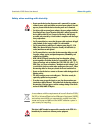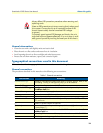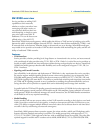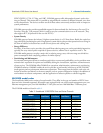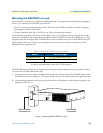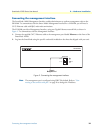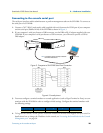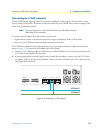
SN10200 overview 14
SmartNode 10200 Series User Manual 1 • General Information
SN10200 overview
Service providers are adding VoIP
capabilities to their networks,
whether to reduce costs when inter-
connecting with other carriers, to
cost-effectively build out their net-
work footprints, or simply to trans-
port voice traffic across their IP
backbones. This can be best accom-
plished using a 16 to 64 E1/T1
SmartNode 10200 Series media gateway, which enables the delivery of VoIP services by bridging voice traffic
between the public switched telephone network (PSTN)—based on time-division multiplexing (TDM)—and
IP networks such as the Internet. Whether sitting at the network core or at the edge, SmartNode media gate-
ways enable service providers to introduce VoIP into their networks while maintaining the quality and the reli-
ability of traditional TDM networks.
Features
• TDM Interfaces
Service providers, whether providing local, long-distance or international voice services, are interconnected
with a multitude of other providers using T1/E1, DS3 or STM-1 links. It is critical for service providers to
be able to rapidly establish new interconnections without having to always deploy new devices. SmartNode
10200 Series media gateways therefore offer flexibility and can be configured to support T1/E1, DS-3 or
STM-1 interfaces.
• Signaling and Control Protocols:
Just as flexibility in the selection and deployment of TDM links is a key requirement for service providers,
the need to support multiple signaling protocols across various carrier partners is just as important. Each
SN10200 media gateway provides support for the concurrent use of ISDN, SS7/C7, CAS (R2), SIP, and
SIGTRAN signaling in the same device. The ability to provide both switching and conversion across multi-
ple TDM and IP signaling protocols at once is paramount to enabling the operational flexibility and cost
savings that drive service providers to expand their carrier relationships and converge their networks.
In parallel with the TDM and IP signaling protocols mentioned above, SN10200 devices also support the
H.248 media gateway control protocol, which enables any H.248-compliant 3-party softswitch to control a
media gateway. While the softswitch manages call control interactions, the SN10200 handles transmission
of call media as well as any required transcoding.
• Media Handling
Service providers will use one or more codecs on their VoIP networks according to their desire to save band-
width, to provide a certain level of voice quality, or simply to interoperate with other VoIP devices or pro-
viders. The ability to support multiple different concurrent codecs and to allocate them in real time based
on traffic is the key to delivering true network convergence.
SmartNode 10200 gateways feature extensive support for various wireline, mobile and IP telephony audio
formats, delivering seamless transcoding in real-time. The media gateways ship with support for G.711,
G723.1, G.726, and G.729ab right out of the box, with no additional license fee required. They also offer
optional support for mobile and IP vocoders such as AMR, AMR-WB (G.722.2), GSM-FR/GSM-EFR,








